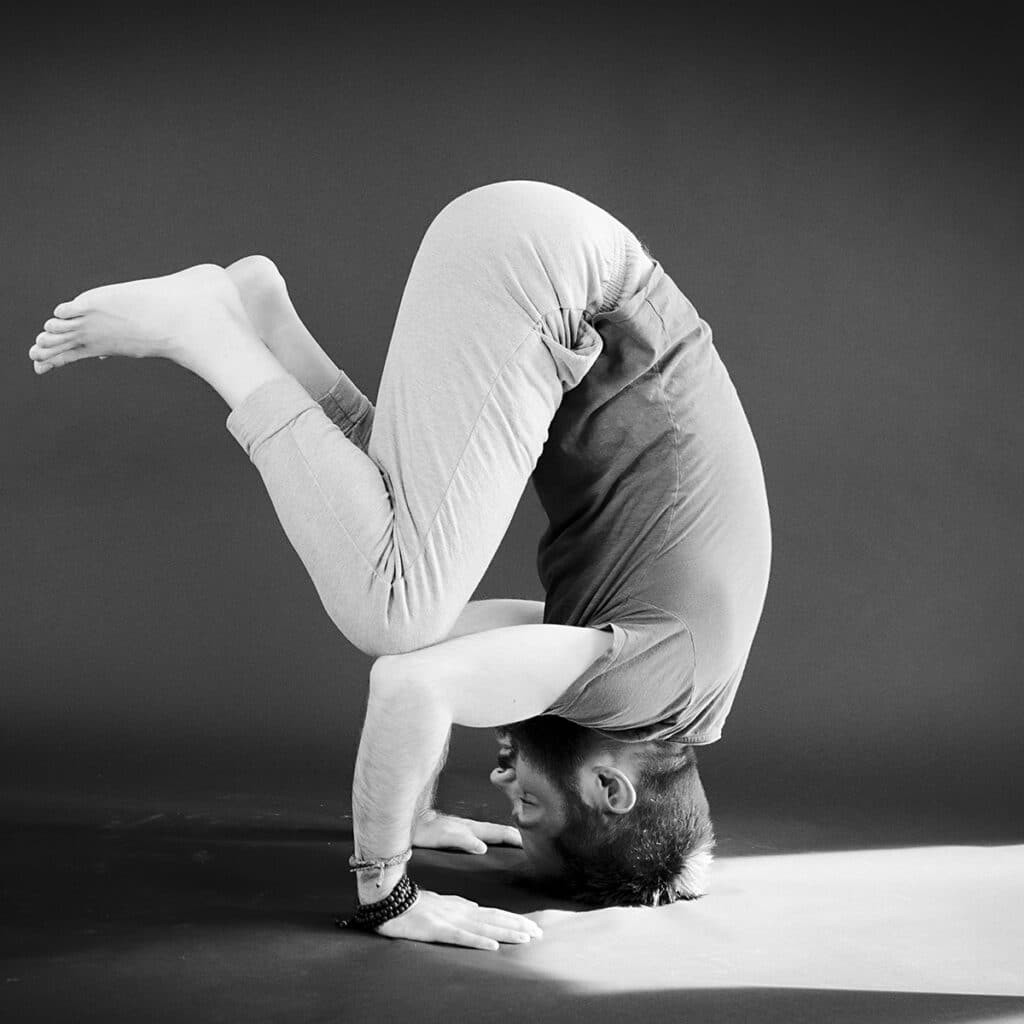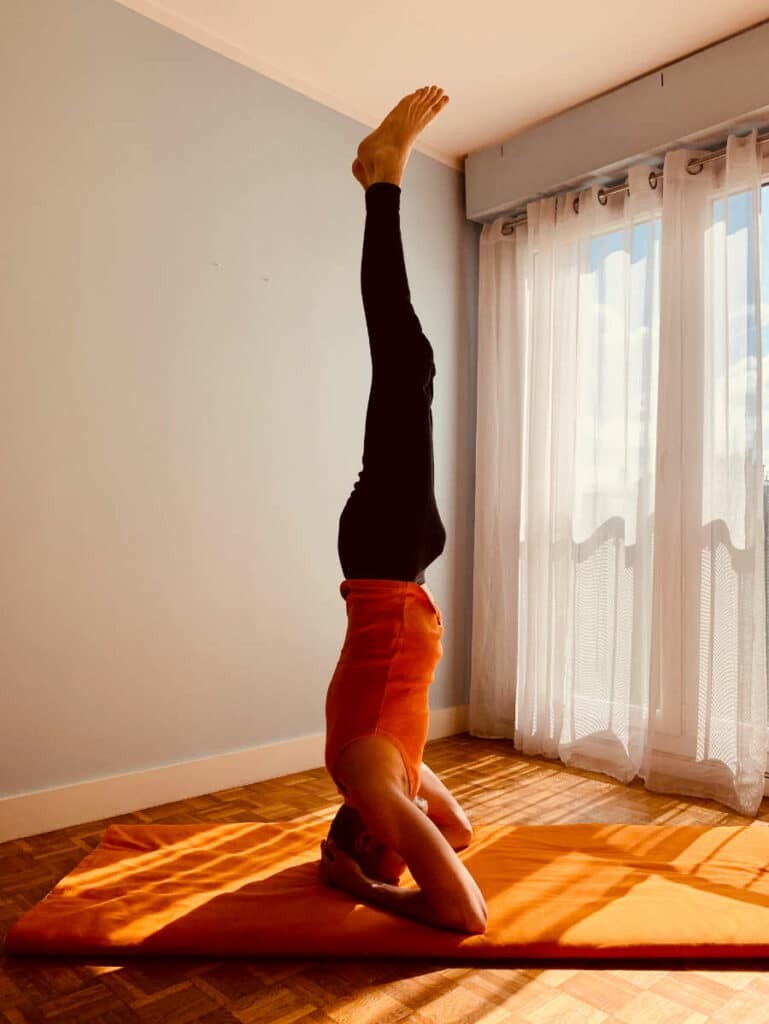Learning the headstand, or Sirsasana, is a rewarding journey accessible to many with the proper approach. At LEARNS.EDU.VN, we guide you through each step, ensuring safety and efficiency. Discover how long it realistically takes to master this beneficial yoga pose and gain the skills to achieve it confidently. This guide will explore effective training, balance improvement, and inversion mastery, providing you with valuable techniques to excel in your headstand practice.
1. Is Headstand Right for You? Essential Considerations
Before embarking on your headstand journey, it’s important to consider whether this inversion is suitable for you. Here’s a breakdown of contraindications and important factors to keep in mind:
- Pre-existing Conditions: Certain medical conditions require caution or make headstand inadvisable.
- Brain Hemorrhage: Avoid headstand if you have a history of brain hemorrhage.
- Serious Hypertension: High blood pressure needs to be well-managed before attempting headstand. Consult your doctor.
- Neck Vertebrae Issues: If you have problems with your neck vertebrae, proceed with extreme caution and consult a medical professional.
- Glaucoma: Headstand can increase pressure in the eyes, so those with glaucoma should exercise caution.
- Overweight: Individuals who are significantly overweight may find headstand more challenging and should proceed slowly.
- Consult a Professional: It’s always best to seek advice from a healthcare provider or qualified yoga instructor if you have any doubts.
- Pregnancy: Headstands are generally not recommended during pregnancy, especially if you are new to the pose.
2. The Clown Pose: Your Gentle Introduction to Headstand
Before diving into the full headstand, start with the Clown Pose, a modified and accessible version. This pose offers numerous benefits:
- Reduced Neck Strain: It distributes weight between your forearms, hands, and head, relieving pressure on your neck.
- Core Strengthening: It engages and strengthens your core muscles, essential for balance in the full headstand.
- Balance Training: It helps develop your sense of balance in an inverted position.
- Problem Identification: It allows you to identify any potential issues or discomfort before attempting the more demanding full headstand.
2.1. How to Perform the Clown Pose
- Begin in a kneeling position.
- Place your head on the floor with the crown of your head touching the mat.
- Position your hands on the floor, shoulder-width apart, with your fingers spread wide for stability.
- Lift your knees off the floor and bring them to rest on your elbows.
- Engage your core muscles and maintain a steady breath.
Practice the Clown Pose regularly to build strength and confidence before progressing to the full headstand. For detailed instructions and more tips, visit LEARNS.EDU.VN for a complete guide to the Clown Pose and its benefits.
3. Why Skip the Wall? Learning Headstand Without Support
Many instructors suggest using a wall for support when learning headstand. However, there are compelling reasons to avoid this approach:
- False Sense of Security: Walls can prevent backward falls but offer no protection against side falls, which can be more dangerous for your neck.
- Hindrance to Balance Development: Relying on a wall inhibits the development of intrinsic balance and stability.
- Lack of Confidence: Once the wall is removed, you must still learn to balance independently, which can be daunting.
- Encourages Bad Habits: It may encourage leaning or incorrect alignment, hindering progress in the long run.
- Importance of Soft Falling: Learning to fall safely is a crucial skill that is best acquired from the beginning.
4. Preparing Your Space: Creating a Safe Practice Environment
Before you begin practicing headstand, ensure your environment is safe and conducive to learning.
- Clear the Area: Remove any furniture, objects, or obstructions that could cause injury if you fall.
- Yoga Mat Selection: Choose a yoga mat that provides adequate cushioning and grip. Thinner latex or rubber mats may not offer enough support.
- Consider a Futon Mat: These mats provide excellent support for static yoga poses, offering a balance between cushioning and stability.
- Avoid Overly Thick Mats: Mats that are too thick can make the pose unstable.
- Additional Cushioning: If your mat is thin, place a folded blanket on top for extra padding.
5. Forearm Support: Protecting Your Neck in Headstand
There are different techniques for performing headstand. The tripod headstand, where hands are placed on the floor, is easier to learn initially but places all the weight on your neck. The recommended method involves forearm support:
- Weight Distribution: Forearm support distributes your body weight to your forearms, relieving pressure on your neck.
- Stability: Forearm support offers greater stability compared to the tripod version.
- Less Strain: This method is less strenuous and allows you to hold the pose for longer periods.
5.1. Step-by-Step Guide to Base Position with Forearm Support
- Start Kneeling: Kneel on your mat. You can fold the mat or place a folded blanket in front of you for added comfort.
- Measure Elbow Distance: Place your thumbs on the inside of your elbows to determine the correct distance between them.
- Place Elbows: Position your elbows on the mat in front of you, maintaining the measured distance.
- Interlace Fingers: Interlock your fingers, creating a cradle for the back of your head.
- Position Head: Place the crown of your head on the mat in front of your hands, with the back of your head resting in your cupped hands.
This is the foundation for a safe and effective headstand. Practice this base position to ensure comfort and stability before moving on.
6. Mastering the Art of Falling: Safe Exit Strategies
Learning how to fall out of headstand safely is paramount. It’s inevitable that you’ll lose your balance as you learn.
- Natural Reflex: Train yourself to instinctively fall correctly.
- Chin to Chest: Flex your neck and bring your chin to your chest.
- Forward Roll: Round your back and roll forward. This distributes the impact of the fall and prevents injury.
- Avoid Rigid Falls: Do not fall stiffly like a tree trunk. This can result in injury.
- No Side Falls: It is crucial to avoid falling to the side, as this can strain your neck.
6.1. Exercise: Practicing the Fall
- Start in Base Position: Begin in the forearm-supported base position.
- Walk Forward: Walk your feet forward until your back is in a vertical line.
- Initiate Roll: Give yourself a gentle push and roll over onto your back.
- Repeat: Practice this exercise several times to build confidence and muscle memory.
This exercise will help you develop the necessary reflexes and reduce the fear of falling, making your headstand practice safer and more enjoyable.
7. Step-by-Step: Getting Into Headstand Safely
Once you’re comfortable with falling, follow these steps to safely enter the headstand:
- Base Position: Start in the forearm-supported base position.
- Raise Knees: Lift your knees off the floor.
- Walk Forward: Walk your feet towards your head until your back is in a vertical line.
- Engage Core: Engage your core muscles for stability.
- Lift Feet: Gradually lift your feet off the floor, keeping your knees bent and heels close to your buttocks.
- Find Balance: Maintain balance with your legs bent, focusing on a steady breath.
- Extend Legs: Once stable, slowly extend your legs upwards, one at a time, reaching the final vertical position.
Remember to practice falling out of the pose if you feel unstable at any point. Consistency and patience are key.
8. Staying in Headstand: Building Endurance and Finding Your Balance Point
Initially, you may only be able to hold the headstand for a few seconds. With consistent practice, your balance will improve, and you’ll be able to stay in the pose longer.
- Find Balance: Focus on finding your exact balance point, ensuring your body is aligned vertically.
- Engage Arms: Consciously use your arms to support some of your body weight, relieving your neck.
- Vertical Alignment: Ensure your body is straight on a plumb line. Ask someone to check your alignment or film yourself.
- Set a Goal: Aim to hold the headstand comfortably for ten minutes to master the pose.
8.1 Common Mistakes to Avoid
- Fear of Falling: Many beginners hesitate to lift their legs fully, which prevents them from finding their balance point.
- Incorrect Alignment: Poor alignment can lead to instability and strain.
- Overreliance on Neck: Remember to engage your arms and core to support your weight.
9. Integrating Headstand into Your Routine: When and How to Practice
Consistency is key to mastering headstand. Here’s how to integrate it into your practice:
- Timing: Practice yoga poses at least two hours after your last meal, especially inversions like headstand.
- Frequency: Practice headstand daily for 5 minutes until you can maintain the pose without losing balance.
- Warm-up: Begin with gentle stretches and warm-up exercises to prepare your body.
- Independent Practice: Practice headstand separately from your regular yoga sequence, as it can be disruptive to the body and nervous system.
- Pre-Practice: Start with Shavasana to cultivate calm and focus.
- Post-Practice: End your practice with a few minutes of standing still with closed eyes, followed by a few minutes of Shavasana.
- During Sequence: If you are doing a yoga sequence that includes headstand, attempt the pose once or twice. If you can’t stay in it, switch to the Clown Pose.
10. Useful Tips and Tricks to Improve Headstand
Here are some additional tips to enhance your headstand practice:
| Tip | Description | Benefit |
|---|---|---|
| Train Regularly | Consistent practice is crucial for developing balance and strength. | Improves balance and stability, making the pose easier to achieve. |
| Visualize Success | Before attempting the headstand, visualize yourself successfully performing the pose. | Conditions your mind for success and reduces anxiety. |
| Use Affirmations | If visualization is challenging, use positive affirmations like “I can easily stay in full headstand” before practicing. | Boosts confidence and positive mindset. |
| Meditate Beforehand | Meditate or practice Shavasana for ten minutes before headstand to calm your mind and body. | Reduces stress and improves focus. |
| Meditate in the Pose | Focus on your breath or body sensations while in the headstand. | Prevents distracting thoughts and enhances your connection to the pose. |
| Core Engagement | Actively engage your core muscles throughout the pose to maintain stability. | Protects your lower back and helps you maintain balance. |
| Gradual Progression | Progress slowly, mastering each step before moving on to the next. | Prevents injury and builds confidence. |
| Listen to Your Body | Pay attention to any discomfort or pain and adjust your practice accordingly. | Prevents overexertion and injury. |
| Seek Guidance | Work with a qualified yoga instructor who can provide personalized guidance and adjustments. | Ensures correct alignment and technique. |
| Patience and Persistence | Learning headstand takes time and dedication. Be patient with yourself and persistent in your practice. | Reinforces commitment and builds confidence in your ability to achieve your goals. |


11. Debunking Common Myths
| Myth | Reality |
|---|---|
| Headstand is only for flexible people | Headstand is accessible to most people with consistent practice and the right approach, regardless of initial flexibility. |
| You need a wall to learn headstand | Learning without a wall can promote better balance and awareness. It is a myth that walls are absolutely necessary. |
| Headstand is dangerous | When practiced with proper alignment, precautions, and awareness of contraindications, headstand can be a safe and beneficial pose. |
| Headstand is an advanced pose | While it requires some strength and balance, headstand can be learned by beginners with patience, proper guidance, and progressive steps. |
| You need to hold it for long periods | Even holding headstand for a few seconds or minutes offers benefits. Gradually increasing the duration is more important than starting with long holds. |
| Headstand is a strength exercise | Although headstand does require some strength, it’s primarily about balance, alignment, and body awareness. The pose also benefits circulation and calms the nervous system. |
| Headstand should be done every day | While regular practice is beneficial, it’s essential to listen to your body and take rest days when needed to prevent overexertion or injury. |
| Headstand is a one-size-fits-all pose | Headstand should be modified based on individual needs, abilities, and limitations. There are variations that accommodate different body types and health conditions. |
| All headstands are the same | There are different variations of headstand, each with its own set of benefits and challenges. Understanding and practicing different variations can enhance your yoga practice. |
| If you can’t do it, you’re failing | Learning yoga poses, including headstand, is a journey, not a destination. There will be progress and setbacks along the way, so celebrating small achievements and learning from challenges are essential. |
12. Headstand and Brain Function
Research has indicated that headstand can have a positive impact on brain function through a number of mechanisms:
| Mechanism | Description | Source |
|---|---|---|
| Enhanced Circulation | Inversions like headstand increase blood flow to the brain, which can improve oxygen and nutrient supply to brain cells. | de Oliveira, L. F., et al. (2018). “Effects of Yoga on Brain Structure and Function; A Systematic Review.” Brain Plasticity, 4(1), 25-42. |
| Stress Reduction | Practicing headstand and other yoga poses can reduce stress hormones like cortisol, promoting a sense of calm and mental clarity. | Streeter, C. C., et al. (2012). “Effects of Yoga Versus Walking on Mood, Anxiety, and Brain GABA Levels: A Randomized Controlled MRS Study.” Journal of Alternative and Complementary Medicine, 18(12), 1145-1152. |
| Improved Focus and Concentration | Regular yoga practice, including inversions, can enhance cognitive functions such as focus, concentration, and memory. | Gothe, N. P., et al. (2019). “The Effects of Yoga on Cognitive Functioning: A Systematic Review and Meta-Analysis.” Journal of Alzheimer’s Disease, 68(3), 1267-1284. |
| Modulation of Neurotransmitters | Yoga and inversions have been shown to influence neurotransmitter levels, such as GABA, which can reduce anxiety and improve mood. | Hölzel, B. K., et al. (2011). “Mindfulness practice leads to increases in regional brain gray matter density.” Psychiatry Research: Neuroimaging, 191(1), 36-43. |
| Enhanced Proprioception and Body Awareness | Headstand requires precise body alignment and control, which enhances proprioception (the sense of body position and movement). | Büssing, A., et al. (2012). “Body image and body awareness in female yoga practitioners.” Evidence-Based Complementary and Alternative Medicine, 2012, 1-12. |
| Stimulation of the Vestibular System | Inversions challenge the vestibular system, which is responsible for balance and spatial orientation. This can improve balance and coordination. | Woollacott, M., & Shumway-Cook, A. (2002). “Attention and the control of posture and gait: A review of an emerging area of research.” Gait & Posture, 16(1), 1-16. |
| Potential for Neuroplasticity | Regular yoga practice has been associated with neuroplasticity, the brain’s ability to reorganize itself by forming new neural connections, which can improve cognitive flexibility and resilience. | Lazar, S. W., et al. (2005). “Meditation experience is associated with increased cortical thickness.” NeuroReport, 16(17), 1893-1897. |
| Improved Cerebrospinal Fluid Circulation (CSF) | Inversions may enhance the circulation of cerebrospinal fluid, which helps clear metabolic waste products from the brain. | Spector, J. T., & Snider, J. T. (2010). “Cerebrospinal fluid physiology and hydrocephalus: clinical implications.” Journal of Neuroscience Nursing, 42(3), 145-153. |
| Activation of the Parasympathetic Nervous System | Yoga inversions can stimulate the parasympathetic nervous system, which promotes relaxation, reduces heart rate, and lowers blood pressure, thereby reducing stress and promoting mental well-being. | Jerath, R., et al. (2006). “Physiological effects of yoga.” Medical Clinics of North America, 95(1), 189-201. |
| Integration of Mind and Body | The practice of headstand integrates physical and mental efforts, fostering a holistic sense of well-being and cognitive coherence. | Villemure, C., & Bushnell, M. C. (2009). “Cognitive modulation of pain: how interactions between attention and emotion influence pain perception.” Pain, 148(3), 356-360. |
Disclaimer: This information is for informational purposes only and should not be considered medical advice. Always consult with a healthcare professional before starting any new exercise or health regimen.
13. How Long Does It Really Take? Realistic Timelines for Learning Headstand
The time it takes to learn headstand varies significantly from person to person. Several factors influence the learning process:
- Physical Condition: Current strength, flexibility, and balance.
- Practice Consistency: Regular, dedicated practice yields faster results.
- Learning Style: Some learn quickly, while others require more time.
- Prior Experience: Previous yoga or fitness experience can be beneficial.
- Fear Factor: Overcoming fear and building confidence are crucial.
Here’s a general timeline:
| Timeline | Description | Activities |
|---|---|---|
| 1-4 Weeks | Building foundational strength and balance. Getting comfortable with the Clown Pose and learning to fall safely. | Daily Clown Pose practice, core strengthening exercises, fall practice. |
| 1-3 Months | Progressing to partial headstand and gradually increasing the duration. | Practice forearm balance, gradual leg raises, wall-assisted practice (if desired, but not required). |
| 3-6 Months | Achieving full headstand and refining balance. | Consistent headstand practice, core strengthening, balance exercises, meditation. |
| 6+ Months | Maintaining and deepening the practice. Exploring variations and holding the pose for longer durations. | Regular headstand practice, advanced yoga poses, mindful breathing exercises. |
| Instant | Rare occurrences of individuals achieving headstand on their first try. | N/A, typically those with extensive experience in similar skills |
| Longer | Some individuals may require more than six months to achieve full headstand due to various personal factors. | Maintaining consistent practice, exploring modified poses or alternatives, seeking personalized guidance from instructors |
Most dedicated individuals can learn headstand within a few weeks to months of consistent practice. Be patient with yourself and celebrate small achievements along the way.
14. Maintaining a Consistent Practice
Once you can perform a headstand, consistency is key. However, there are some additional factors that you need to consider to ensure your journey is successful:
| Practice Consideration | Description |
|---|---|
| Listening to Your Body | Pay attention to your body and sensations, and make changes to your poses as needed. |
| Awareness of your Environment | Pay attention to your surroundings, and make any adjustments necessary. |
| Check your Breathing | Coordinate your breath with each step and movement. |
| Check Your Posture | While it is important to push and challenge yourself, it is more important to make sure that your posture is correct to avoid injuries. |
| Mindfulness | Focus and calm your mind. |
| Consider Your Diet | Your diet is the fuel for all your workouts. Consider a change in diet to include foods that improve focus, alertness, and energy, which may improve results. |
| Time of Day | Do you perform at your peak in the morning, noon, or night? When are you most alert? These are important considerations when maintaining a consistent practice. |
| Consistency of Time | Consistency is key. To keep a consistent practice, the time should also remain consistent. |
| Short-Term Attainable Goals | Goals are important to track progress and stay motivated. However, goals should be short-term and attainable to keep the practice consistent. |
| Mix and Match Your Routine | If you are bored with your routine, mix and match. Keep the routine and time consistent but make minor adjustments to your practice. |
| Celebrate Milestones and Reward Goals | Celebrating milestones and rewarding yourself can maintain focus and consistency, which makes it fun. |
| Overcoming Obstacles | There will always be obstacles that prevent maintaining a consistent practice. There must be a plan to overcome those obstacles. |
| Ask for Help from Friends and Family | It is important to surround yourself with friends and family who understand your objectives and goals. Having moral support and assistance when needed can help maintain a consistent practice. |
15. The Journey Awaits: Embrace the Headstand Challenge
Learning headstand is a journey that combines physical strength, mental focus, and unwavering dedication. By following these guidelines, you can approach this challenging pose with confidence and safety. Embrace the process, celebrate your progress, and enjoy the many benefits that headstand offers.
FAQ: Common Questions About Learning Headstand
Here are some frequently asked questions about learning headstand:
- Is headstand safe for everyone? No, headstand is not safe for individuals with certain medical conditions like brain hemorrhage, serious hypertension, neck problems, or glaucoma. Consult a healthcare professional before attempting.
- Can I learn headstand if I’m not flexible? Yes, flexibility is not a prerequisite. With consistent practice and proper technique, you can gradually improve your flexibility and learn headstand.
- How often should I practice headstand? Aim to practice 5 minutes daily until you can maintain the pose without losing balance.
- Is it better to learn headstand with or without a wall? Learning without a wall promotes better balance and awareness. Walls may create a false sense of security and hinder progress.
- What if I’m afraid of falling? Practice falling safely from the base position to build confidence and reduce fear.
- How long should I hold headstand when I first start? Start with short intervals of a few seconds and gradually increase the duration as your strength and balance improve.
- What are the benefits of headstand? Headstand improves circulation, strengthens core muscles, calms the nervous system, and enhances focus and concentration.
- Can I do headstand during menstruation? Some women prefer to avoid inversions during menstruation, while others find them relieving. Listen to your body and do what feels right for you.
- What should I do if I feel pain in my neck during headstand? Stop immediately and reassess your alignment and technique. Ensure you are using your forearms to support your weight. If pain persists, consult a yoga instructor or healthcare professional.
- Where can I find more resources and guidance for learning headstand? Visit LEARNS.EDU.VN for detailed articles, instructional videos, and expert advice on mastering headstand and other yoga poses.
Ready to begin your headstand journey? Discover more valuable tips, detailed tutorials, and personalized guidance at LEARNS.EDU.VN. Our comprehensive resources and expert instructors are here to support you every step of the way.
Contact Us:
- Address: 123 Education Way, Learnville, CA 90210, United States
- WhatsApp: +1 555-555-1212
- Website: LEARNS.EDU.VN
Start your transformation today with learns.edu.vn.

